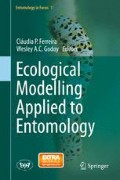Abstract
Dengue incidence is dependent on abiotic factors that directly affect the population dynamics of mosquitoes with serious implications for dengue transmission. By using estimated entomological parameters dependent on temperature, and including the dependency of these parameters on rainfall, the seasonally varying population size of the mosquito Aedes aegypti is evaluated using a mathematical model. The anthropophilic and peridomestic female A. aegypti bite humans for blood to mature fertilised eggs, during which the dengue virus can spread between mosquitoes and humans. As an example of applied entomology, mosquito and human populations are coupled to assess dengue virus transmission. Seasonal patterns of mosquito populations influence dengue epidemics, illustrating the importance of temperature and rainfall in designing control mechanisms.
Access this chapter
Tax calculation will be finalised at checkout
Purchases are for personal use only
Notes
- 1.
Data provided by Sucen (Superintendência de Controle de Endemias).
References
Anderson RM, May RM (1991) Infectious diseases of humans: dynamics and control. Oxford University Press, Oxford/New York/Tokyo, 757p
Baruah S, Dutta P (2012) Seasonal pattern of abundance of Aedes albopictus in urban and industrial areas of Dibrugarh District Assam. Asian J Exp Biol Sci 3:559
CEPAGRI/UNICAMP (2012) Centro de Pesquisa Meteorológicas e Climáticas Aplicadas à Agricultura. http://www.cpa.unicamp.br/. Accessed 2 December 2012
Dickerson AK, Shankles PG, Madhavan NM, Hu DL (2012) Mosquitoes survive raindrop collisions by virtue of their low mass. Proc Natl Acad Sci 109:9822
Esteva L, Vargas C (2003) Coexistence of different serotypes of dengue virus. J Math Biol 46:31
Instituto de Açúcar e Álcool (2012) Centro integrado de informações agrometeorológicas. http://ciiagro.iac.sp.gov.br/. Accessed 2 December 2012
Koenraadt CJM, Harrington LC (2008) Flushing effects of rain on container-inhabiting mosquitoes Aedes aegypti and Culex pipiens (Diptera: Culicidae). J Med Entomol 45:28
Lindsay SW, Birley MH (1996) Review: climate change and malaria transmission. Ann Trop Med Parasitol 90:573
Madi M, Ahmad E, Kulaimi NAM, Ali WM, Ismail S, Lim LH (2012) Climatic influences on Aedes mosquito larvae population. Malays J Sci 31:30
Micieli MV, Campos RE (2003) Oviposition activity and seasonal pattern of population of Aedes (stegomya) aegypti (L) (Diptera: Culicidae) in subtropical Argentina. Mem Inst Oswaldo Cruz 98:659
Moore CG, Cline BL, Ruiz-Tiben E, Lee D, Romney-Joseph H, Rivera-Correa E (1978) Aedes aegypti in Puerto Rico: environmental determinants of larva abundance and relation to dengue virus transmission. Am J Trop Med Hyg 27:1225
Regis L, Monteiro AM, Melo-Santos MAV et al (2008) Developing new approaches for detecting and preventing Aedes aegypti population outbreaks: basis for surveillance, alert and control system. Mem Inst Oswaldo Cruz 103:50
Toma TS, Sakamoto S, Miyagi I (1982) The seasonal appearance of Aedes aegypti in Okinawajina, the Ryukyu archipelago, Japan. Jpn Mosq News 42:179
Vezzani D, Velazquez SM, Schweigmann N (2004) Seasonal pattern of abundance of Aedes aegypti (Diptera: Culicidae) in Buenos Aires City, Argentina. Mem Inst Oswaldo Cruz 99:351
Yang HM (1999a) Directly transmitted infections modeling considering age-structured contact rate. Math Comput Model 29:39
Yang HM (1999b) Directly transmitted infections modeling considering age-structured contact rate – epidemiological analysis. Math Comput Model 29:11
Yang HM, Macoris MLG, Galvani KC, Andrighetti MTM, Wanderley DMV (2009a) Assessing the effects of temperature on the population of Aedes aegypti, vector of dengue. Epidemiol Infect 137:1188
Yang HM, Macoris MLG, Galvani KC, Andrighetti MTM, Wanderley DMV (2009b) Assessing the effects of temperature on dengue transmission. Epidemiol Infect 137:1179
Yang HM, Macoris MLG, Galvani KC, Andrighetti MTM (2011) Follow up estimation of Aedes aegypti entomological parameters and mathematical modellings. BioSystems 103:360
Acknowledgments
We thank financial support from FAPESP (Projeto Temático, grant 2009/15098-0) and CNPq (Edital Universal, grant 477034/2011-0).
Author information
Authors and Affiliations
Corresponding author
Editor information
Editors and Affiliations
Rights and permissions
Copyright information
© 2014 Springer International Publishing Switzerland
About this chapter
Cite this chapter
Yang, H.M. et al. (2014). Abiotic Effects on Population Dynamics of Mosquitoes and Their Influence on Dengue Transmission. In: Ferreira, C., Godoy, W. (eds) Ecological Modelling Applied to Entomology. Entomology in Focus, vol 1. Springer, Cham. https://doi.org/10.1007/978-3-319-06877-0_3
Download citation
DOI: https://doi.org/10.1007/978-3-319-06877-0_3
Published:
Publisher Name: Springer, Cham
Print ISBN: 978-3-319-06876-3
Online ISBN: 978-3-319-06877-0
eBook Packages: Biomedical and Life SciencesBiomedical and Life Sciences (R0)

